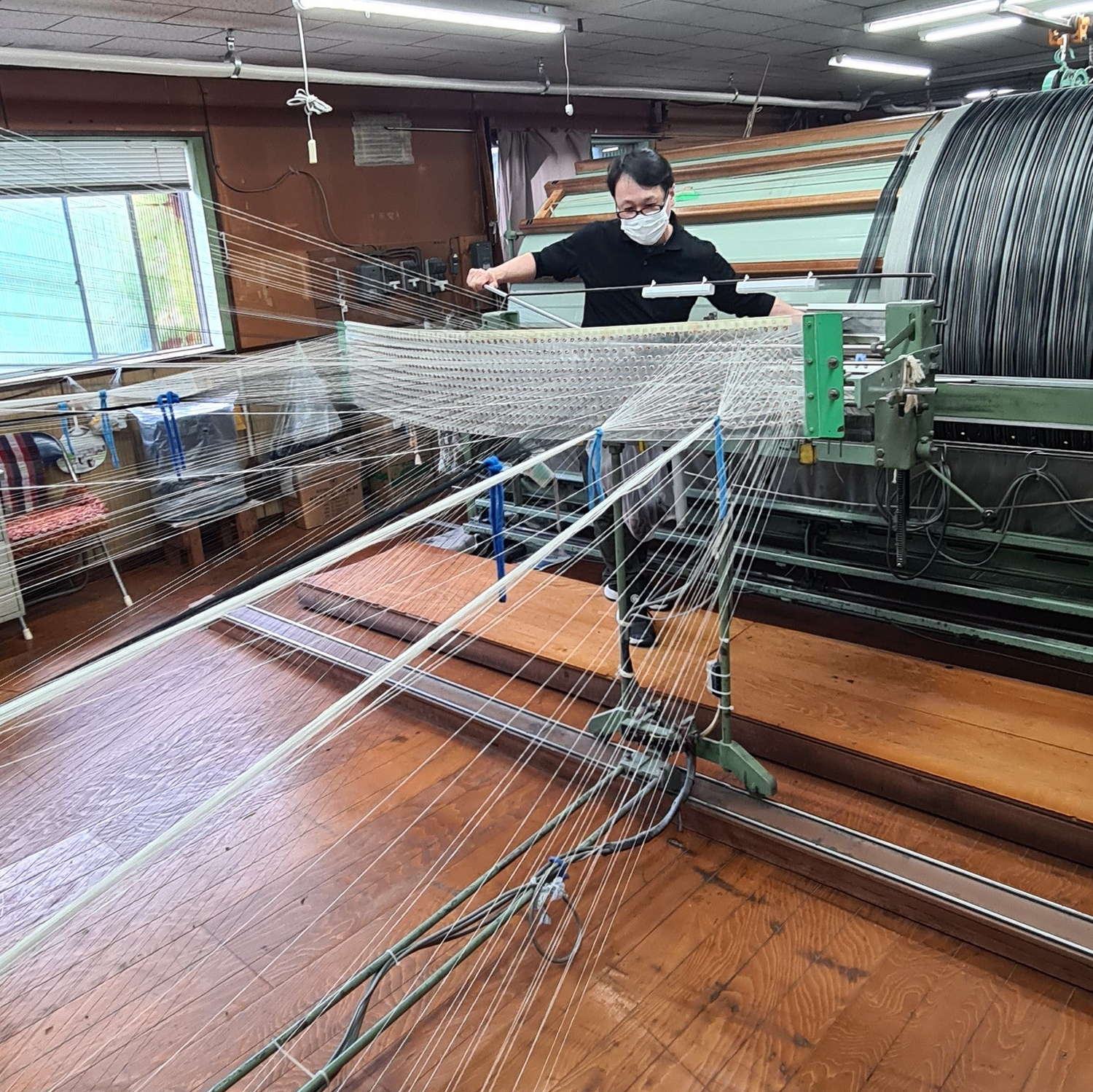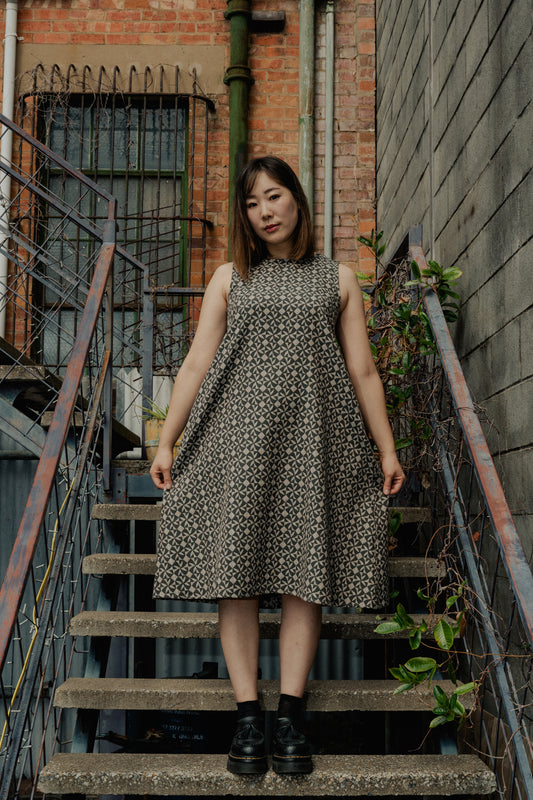Collection: Vol.1 “Wearing Weaving”
I visited the Takumi Dream Association in May 2024, and learnt so much about weaving and its history. I was introduced to Mr Ohta and talented staff, Ms Hara. They showed me their weaving studios and production methods. It was completely different to how I imagined. I thought the process would be mechanised in a factory full of computer-controlled machinery. Instead, I learnt that most of the weaving process was completed by the hands of skilled craftsmen.
Mr Ohta told me that the company had spent $300,000 on a computer-controlled machine to weave that was discovered incompetent in comparison to the experienced and skilled artisans. They found the hi-tech machine could not master the complex techniques and designs the company produced by hand.
Mr Ohta told me stories of how there were over 100 weaving studios in the city in the 1980s. Now, only a few remain. There is limited stock of original fabrics which were woven from leftover threads. The new design’s fabrics include tencel and recycled pe.
As we returned to the meeting room, I saw thousands of swatches in the room adjacent. The swatches were all created by order to Japanese fashion brands. They were incredible, and I thought of how I could display this variety of weaves to the world.
I inquired to Mr Ohta about any stock I could present for this project. Unfortunately, he had no stock at hand as the swatches were created by contract between the company and different fashion brands.
I proposed an idea to Mr Ohta: we could display the available stocked fabrics by presenting ten various Sakizome dresses. While it was a very different experience and business venture, he gladly accepted my proposal. I hope this is only the beginning, and the project can continue and evolve greater.

What is Sakizome fabric?
"Sakizome" fabric are textiles woven from threads that have been dyed beforehand. By weaving these coloured warp and weft threads together, it creates various patterns such as checks and stripes. Different combinations of thread types, thicknesses, and arrangements allow for the creation of a wide range of patterns and textures. While producing this fabric incurs higher manufacturing costs, its dyed threads minimise colour fading. This is a key characteristic that highlights the high quality of this fabric.
染色で色をつけた糸で織った生地を先染(さきぞめ)織物と言います。
色のついたタテ糸とヨコ糸で織ることで、チェックやストライプの生地が出来上がります。また、糸の種類、太さ、並べ方の組み合わせで様々な模様やテクスチャーを作り出すことができます。
生地を作るために製造コストがかかってしまいますが、原料から染めているため色落ちが少ないのが特徴です。

Mitsuke City, Niigata, Japan
Mitsuke City is a rural area rich in nature, located approximately 300km North-West of Tokyo. It is surrounded by mountains and rice fields, and is renowned for its rice production. It has also been a centre for cotton textiles called "Mitsuke Yuki" from the Edo period to the Meiji period (1868-1912). Today, it is still recognised nationwide as a hub for knit and woven textiles.
●日本 新潟県見附市
見附市は東京から約300km離れた山や田んぼに囲まれている自然豊かな田園地帯です。
お米はもちろんですが、江戸時代から明治時代(1868-1912)にかけて「見附結城」と呼ばれる綿織物の産地でした。今でもニットや織などの繊維の産地として全国に知られています。

Takumi Dream Association
Founded in 1958, Takumi no Yume is a textile manufacturer based in Mitsuke, in the Niigata prefecture. Following in the footsteps of their predecessor’s, the company produces fabrics for women's and children's clothing. It uses both natural materials and synthetic fibers. In recent years, it has been developing products that combine two or more materials. Using dobby and jacquard looms, it strives to create original fabrics that can only be woven by the company.
●株式会社匠の夢
1958年創業の新潟県見附産地のテキスタイルメーカーです。前身の会社から引き継ぎ、今まで婦人・子供服用の生地を製造してきました。
天然素材はもちろんのこと、合成繊維の取り扱いもしており、近年は二種類以上の素材を複合させた商品開発を行っています。
ドビー織機、ジャガード織機を使用して、弊社でしか織れないオリジナルの生地作りを心がけています。
The Process of Weaving “Sakizome” Fabric

This is yarn winding. The yarn, in a form called a "kase," is rewound onto bobbins for easier handling.

This photo exhibits the process of warping on a warping machine. The warp threads are arranged in a specific order to create the desired pattern and are wound to the required length. This prepares the warp threads for an artisan to then weave.

This photo displays the process of threading the white warp threads through the reed. The reed determines the density of the warp threads and serves as a tool for spacing the weft threads and as a beam to prevent loose threads. Each thread is carefully woven one by one.

This photo shows a quality inspection. We check the finished fabric for any defects or stains. While some companies outsource this process, we take responsibility and conduct the inspection in-house.
Online Store - Wearing Weaving
-
ジャガードの組織替え模様織り: Jacquard Pattern with Weave Structural Changes
Regular price $169.00 AUDRegular priceUnit price / per -

 Sold out
Sold outドビーの変わり織り: Dobby Pattern Weave
Regular price $169.00 AUDRegular priceUnit price / per -
異番手の平織り: Plain Weave with Different Yarn Sizes
Regular price $229.00 AUDRegular priceUnit price / per -
異番手の平織り: Plain Weave with Different Yarn Sizes
Regular price $169.00 AUDRegular priceUnit price / per -
ジャガードの二重織り: Jacquard Double Weave Dark
Regular price $189.00 AUDRegular priceUnit price / per -
異番手の平織りと朱子織り: Plain Weave with Different Yarn Sizes and Sateen Weave
Regular price $229.00 AUDRegular priceUnit price / per -

 Sold out
Sold outドビーのコード織り: Dobby Cord Weave
Regular price $169.00 AUDRegular priceUnit price / per -

 Sold out
Sold outドビーのグレンチェック: Dobby Glen Check
Regular price $229.00 AUDRegular priceUnit price / per -
ジャガードの二重織り: Jacquard Double Weave Light
Regular price $189.00 AUDRegular priceUnit price / per -

 Sold out
Sold outドビーの変わり織り: Dobby Pattern Weave
Regular price $169.00 AUDRegular priceUnit price / per




















